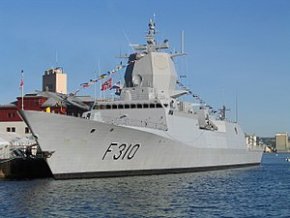I too am a fan of small carriers.
While I fully understand that larger carriers are more efficient than small ones and that large, through deck amphibs are more flexible (to achieve this they need to be larger than a carrier embodying the same or even greater aviation capability), there is also the question of cost, not just of acquisition, but also sustainment. It is without a doubt more efficient to have ten large carriers than twenty medium, generating the same number of sorties, if you need to lift and support a battlegroup based around an Infantry battalion, then your lift ship needs to be a minimum size and capability.
The thing is when you are talking a small or small medium navy, then you are never going to be able to afford large numbers of large ships, and even if you can afford a couple of large multirole ships, then you are faced with the dilemma of not having sufficient hulls to sustain the minimum number required to cover likely operational needs. These few large ships then become a target that requires protection, meaning, at any given point, the bulk of out surface force is escorting our two or three large ships that cant look after themselves, but that we also can't afford to lose.
This is when we need to start looking at which capabilities we can distribute among platforms to provide a greater overall capability that will (hopefully) degrade gracefully in the face of losses. This is why the Hunters are getting AEGIS and MK41 / SM-6, on top of their ASW mission, this is why all our majors have Romeos and Harpoon (NSM soon), and 5" guns, we can't afford any of our larger ships to be so specialised that they become a liability outside of their speciality. It would be great if we could have afforded to replace the Perth Class DDGs, Adelaide Class FFGs and ANZAC class FFHs with a dozen or more Flight IIA Burkes, but it would have been unaffordable.
Something that comes to mind is an LPD with AEGIS, CEAFAR, CEC, configured for ABM and Mk-41, an LPDG?. Such a config would be incompatible with extensive flight operations on a light carrier or an LHD but doable on an LPD, it could even lash HIMARS to the deck. Then you have your Hunters with the same (less the HIMARS) plus their ASW role, and the Hobarts. Or the LPDGs could replace the Hobarts and potentially the LHDs, assuming the planned support ships have a significant, complementary amphibious capability. This is a long term vision, not an instant fix, its a replacement of existing types as they come to the end of their lives, or perhaps come due for major upgrades.
This is where the light carriers come in, they replace the aviation capability lost with the LHDs, are designed for fleet operations in support of the Hunters with additional ASW helos but also surveillance aircraft as well, either manned or unmanned. They could even have an AEW capability with CEC, and dream land here, maybe F-35B. They would have the same core SAAB 9LV combat system and at least ESSM Block II and or RAM. They would also be able to operate as many, or more army helicopter than the LHDs, as the RN used to do with the Invincibles to cover Oceans maintenance periods. There are acquired in numbers, i.e. three or more and complement both the surface fleet and the amphib capability.
The final string is the OPVs, or more to the point the modern day DEs (Destroyer Escorts or patrol frigates) the supplement and supersede them. They will be something in the vein of the RN Type 31/32, and Danish Iver Huitfeldt class and Absalon class frigates. This is where the RAN will have their multirole capability. A core 9LV combat system with CEC, a Mk-41 VLS for ESSM but also able to carry other missile types to be used to their best effect by the LPDG or Hunters they are supporting, a Mk-45 5" gun, hangar large enough for two Romeos or a mix of Romeos and UAVs, a flight deck large enough for a Chinook, and a mission deck able to be configured for mine warfare or Amphibious warfare. These ships could be the basis of a modern day Assault transport (APD) as used so effectively by the USN in WWII (this was also the final role of the surviving ships of the famous RAN Scrap Iron Flotilla).
Going forward, we build the Hunters as planned, growing and evolving them, build the new support ships as planned, ensuring they have dock wells and can supplement the LHDs. Select or design a light carrier to introduce new capabilities and supplement the LHDs, then as sufficient become available to take over the entirety of the LHDs aviation role. Design (adapt / dust off US plans) a LPDG to replace the Canberras and Hobarts.
Switch from OPVs to DEs / APDs, cascading the OPVs to Customs and secondary roles.
Anyway (perhaps for good reason) I am not in a senior CAPDEV role, so there is pretty much zero chance of any of this happening.

